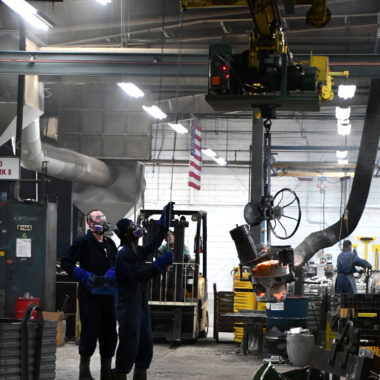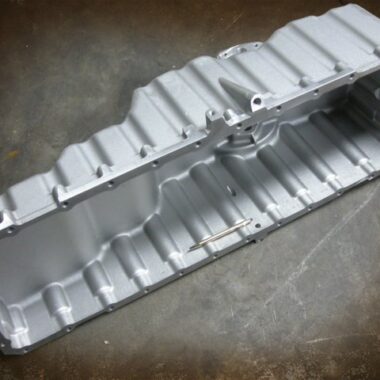Understanding About Aluminum Casting: Strategies Debunked
Understanding About Aluminum Casting: Strategies Debunked
Blog Article
Check Out the Globe of Light Weight Aluminum Casting: Expert Secrets and Strategies
In the realm of production, light weight aluminum spreading stands as a pivotal process, important for the production of a vast selection of items. Behind the apparently uncomplicated strategy exist a plethora of detailed elements, typically unbeknownst to numerous. As we navigate with the world of light weight aluminum spreading, there exists a realm of expert keys and approaches that can boost the high quality of the end products and streamline the manufacturing procedure. By uncovering these concealed treasures and checking out the nuances of this craft, a whole new measurement of opportunities arises, promising to reinvent the method we engage and perceive with aluminum spreading.

The Basics of Light Weight Aluminum Spreading
Aluminum spreading, a basic procedure in production, involves the pouring of liquified light weight aluminum into a mold to achieve preferred forms and structures. This flexible technique is extensively used throughout numerous markets because of aluminum's extraordinary properties such as high strength-to-weight proportion, rust resistance, and thermal conductivity.
The process starts with the melting of light weight aluminum in a heating system at temperatures surpassing 1220 ° F(660 ° C ) Once the light weight aluminum reaches its liquid state, it is put right into a pre-designed mold dental caries. The mold, generally made from products like steel or sand, figures out the final form of the cast aluminum component.
After pouring, the light weight aluminum is delegated solidify and cool down within the mold - about aluminum casting. This cooling duration is essential as it determines the stability and quality of the last product. When strengthened, the mold is gotten rid of, exposing the freshly developed light weight aluminum spreading
Insider Tips for Effective Casting
To attain optimal results in light weight aluminum casting, careful interest to information throughout the mold layout phase is critical for ensuring successful outcomes. Monitoring and regulating the metal temperature level throughout the spreading process can aid protect against concerns such as early solidification or porosity in the final item.
A well-prepared mold surface area can contribute to much better steel flow, reduced disturbance, and enhanced surface coating on the actors component. By paying close attention to these insider pointers, manufacturers can boost the quality and efficiency of their aluminum casting processes.
Advanced Techniques in Aluminum Casting
Making use of ingenious techniques and sophisticated approaches, the realm of aluminum casting has actually seen a substantial evolution towards progressed techniques that push the limits of typical methods. One such strategy is vacuum cleaner spreading, which includes creating a vacuum setting to get rid of air from the mold and mildew cavity, resulting in greater high quality and even more complex spreadings with reduced porosity. Additionally, investment casting, additionally referred to as lost-wax casting, is a refined approach that permits complex shapes and slim wall surfaces, causing thorough and accurate aluminum components.

Moreover, advanced simulation informative post software application plays a crucial role in maximizing spreading styles and anticipating prospective flaws, allowing for adjustments to be made prior to the real casting procedure starts. By embracing these innovative techniques, suppliers can elevate their aluminum casting capabilities to new heights, fulfilling the demands of contemporary markets with accuracy and advancement.
Comprehending Various Casting Techniques
In the realm of production, a comprehensive understanding of various casting approaches is important for attaining optimum results in steel construction procedures. Various spreading methods use special advantages and are selected based on variables such as the intricacy of the layout, production quantity, material needs, and price why not find out more considerations. Among the most common casting approaches is sand spreading, where a mold and mildew is developed using sand as the main material. Sand casting is versatile, cost-efficient, and appropriate for creating large components.
One more preferred casting method is pass away casting, which entails injecting liquified metal right into a mold and mildew tooth cavity under high stress. By comprehending the subtleties of different Find Out More spreading methods, suppliers can make informed choices to optimize their manufacturing procedures and accomplish the wanted outcomes.
Maximizing Effectiveness in Spreading Workflow
With a strong grasp of the subtleties of various casting techniques, suppliers can streamline their procedures to improve performance in steel fabrication procedures. Maximizing effectiveness in casting procedures calls for a systematic method that concentrates on optimizing every step of the casting procedure. One vital strategy is to execute lean production concepts to remove waste and improve overall efficiency. By determining and removing bottlenecks in the production line, makers can boost workflow and reduce lead times.
Additionally, purchasing sophisticated technology and equipment can considerably improve effectiveness in casting operations. Automated systems, robotics, and computer-aided design (CAD) software can streamline procedures, lower mistakes, and boost outcome. Additionally, training employees on the current strategies and ideal methods can likewise add to making the most of efficiency in casting procedures.
Routine maintenance of equipment and devices is important to decrease and stop break downs downtime - about aluminum casting. Implementing an aggressive maintenance timetable can assist identify possible problems before they rise, guaranteeing smooth procedures and undisturbed production. On the whole, by prioritizing performance and constant improvement, makers can optimize their spreading operations and remain competitive in the market

Verdict
Finally, the globe of light weight aluminum spreading uses a vast array of opportunities for those wanting to create sturdy and detailed steel objects. By mastering the essentials, making use of insider suggestions, and exploring innovative strategies, individuals can achieve great success in their spreading ventures. Understanding the numerous spreading methods and maximizing performance in operations are key parts to accomplishing top quality lead to aluminum casting. With devotion and practice, one can absolutely unlock the potential of this functional metalworking process.
One such technique is vacuum spreading, which involves producing a vacuum cleaner environment to remove air from the mold and mildew cavity, leading to higher top quality and more elaborate spreadings with reduced porosity (about aluminum casting). Furthermore, financial investment spreading, additionally known as lost-wax casting, is a polished approach that allows for complicated forms and slim walls, resulting in precise and comprehensive aluminum parts
One of the most typical spreading methods is sand spreading, where a mold and mildew is developed using sand as the primary material.One more prominent spreading approach is pass away spreading, which entails infusing liquified metal into a mold cavity under high pressure. Understanding the different casting techniques and enhancing effectiveness in procedures are crucial elements to accomplishing high-grade outcomes in light weight aluminum spreading.
Report this page